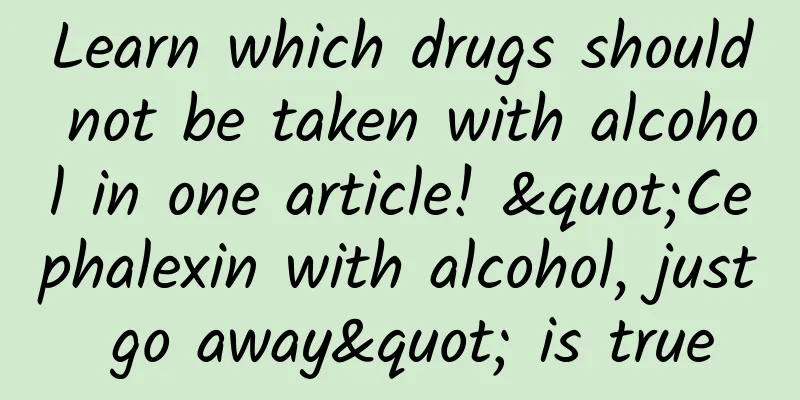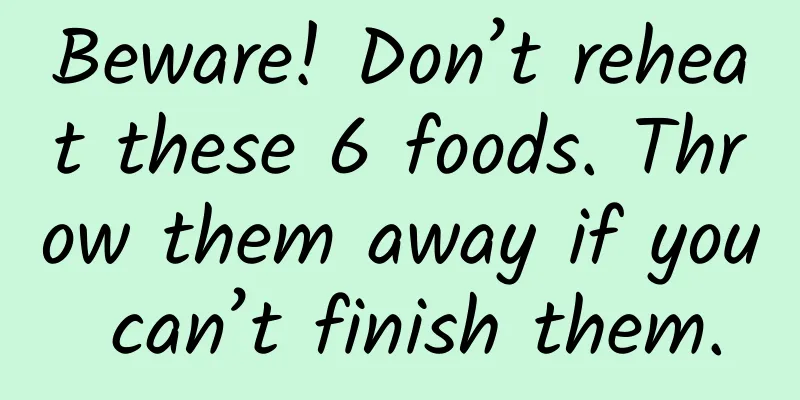Learn which drugs should not be taken with alcohol in one article! "Cephalexin with alcohol, just go away" is true

|
Recently, in Hangzhou, Zhejiang, a delivery boy delivered 10 bottles of beer to a woman's home and found that she was arguing with her boyfriend on a video call. At this time, another delivery boy also came to deliver a box of cephalosporin. The boy realized something was wrong and called 110. The police immediately stopped the woman and sent her to the hospital for treatment. Because the police were called in time, the woman only took 7 cephalosporins and had not drunk any alcohol. After treatment, she is basically fine. As medical knowledge in my country gradually enters the public eye, medical knowledge is no longer "exclusive" to medical students, and more and more people have a certain understanding of the contraindications of drug combinations. "Cephalexin with alcohol, just go" has also become a common saying, and people know that taking the two together is prone to accidents. However, questions such as why cephalosporins cannot be taken together with alcohol, what symptoms will appear, how long after taking cephalosporins can you drink alcohol, and what other drugs besides cephalosporins cannot be taken together with alcohol, and what to do after taking them together have begun to bother the people. Based on this, the editor has sorted and summarized the relevant content in order to be useful for popularizing clinical science to the general public. 1. Cephalosporins and alcohol should not be taken together 1. Cephalosporins can affect alcohol metabolism, causing its metabolite acetaldehyde to accumulate in the body, causing discomfort in the digestive system, respiratory system, circulatory system, nervous system, etc. Mild symptoms include nausea, vomiting, diarrhea, dizziness, sweating, palpitations, etc., and severe symptoms include respiratory depression, myocardial infarction, heart failure, mental confusion, etc. 2. When alcohol meets cephalosporins containing "methylthiotetrazolyl side chain", the acetaldehyde produced by alcohol cannot be oxidized into acetic acid, causing acetaldehyde to accumulate in the body. A disulfiram-like reaction will occur in as fast as 5 minutes or as long as 1 hour. 2. After taking cephalosporins, you can drink alcohol at least 7 days later, which varies from person to person. The order and time in which cephalosporins and alcohol enter the human body depends only on when the cephalosporins and alcohol can be metabolized. In other words, the two cannot coexist! No matter what substance, the metabolic rate in the human body will vary from person to person, so it is most reliable to take a conservative value. Taking cephalosporins before drinking alcohol and taking cephalosporins after drinking alcohol will cause the same damage to the human body, and both will produce disulfiram-like adverse reactions. Therefore, for the sake of health, the interval between drinking and taking cephalosporins should be at least 7 days. 3. Except for cephalosporins, these 9 types of drugs should not be taken with alcohol 1. Gastroenteritis drugs - Furazolidone tablets Furazolidone tablets are mainly used to treat some gastrointestinal diseases, such as bacillary dysentery, enteritis, etc. As a monoamine oxidase inhibitor, after taking furazolidone tablets, hydroxyethylamine metabolites will be generated in the intestines, making the body more sensitive to alcohol. Therefore, when gastroenteritis drugs meet alcohol, it is easier to get drunk. 2. Blood sugar lowering drugs - glibenclamide, metformin, insulin Alcohol can enhance the efficacy of hypoglycemic drugs . For example, when glibenclamide, metformin, and insulin meet alcohol, it may cause hypoglycemia . Common symptoms include palpitations, dizziness, hand tremors, chills, etc. In severe cases, it can cause shock. 3. Sleeping pills - diazepam, triazolam, barbiturates, chloral hydrate **Both sleeping pills and alcohol have the effect of suppressing breathing and heartbeat. **For example, when diazepam, triazolam, barbiturates and chloral hydrate meet with alcohol, they can form a double stimulation , leading to slow brain reaction and even inhibition of respiratory and circulatory centers, resulting in serious symptoms such as slowed respiratory rhythm, low blood pressure, and shock. 4. Antihypertensive drugs - reserpine, nifedipine, nifedipine, captopril Alcohol can dilate blood vessels, inhibit sympathetic nerves and myocardial contraction, and can enhance the efficacy of antihypertensive drugs. For example, when reserpine, nifedipine, nifedipine, and captopril are combined with alcohol, patients may experience symptoms such as headache, dizziness, chest tightness, and even confusion, and in severe cases, may experience hypotensive shock . 5. Anti-epileptic drugs - phenytoin sodium Alcohol may reduce the concentration and efficacy of anti-epileptic drugs . For example, when phenytoin sodium meets alcohol, the drug's efficacy will be quickly lost, greatly reducing the therapeutic effect, making it difficult to control symptoms during an attack . 6. Anti-allergic drugs - diphenhydramine, chlorpheniramine Anti-allergic drugs actually mainly refer to antihistamines. When diphenhydramine and chlorpheniramine meet with alcohol, they will cause adverse reactions such as drowsiness, mental confusion, and coma . 7. Antianginal drugs - isosorbide dinitrate, nitroglycerin, nifedipine Alcohol has the effect of dilating blood vessels. When anti-angina drugs such as isosorbide dinitrate, nitroglycerin, and nifedipine meet with alcohol, it will cause excessive dilation of blood vessels , leading to severe headaches, a sudden drop in blood pressure, and even shock. 8. Antipyretic and analgesic drugs - aspirin, ibuprofen, diclofenac Antipyretic and analgesic drugs can irritate the gastrointestinal mucosa, and if they come into contact with alcohol, they will form a double stimulation. For example, when aspirin, ibuprofen, diclofenac, etc. come into contact with alcohol, they can cause gastrointestinal pain at the mildest, and peptic ulcers or even bleeding at the worst. 9. Cold medicine The effectiveness of cold medicine is related to the reduced glutathione in the body, and alcohol will consume a large amount of glutathione in the body, which is not conducive to the effectiveness of the medicine. In addition, most cold medicines contain acetaminophen, which produces a toxic metabolite during its biotransformation in the body, which needs to be neutralized by the body's reduced glutathione to reduce its toxicity. But when cold medicine meets alcohol, alcohol will consume a large amount of glutathione in the body, causing the body to be attacked by the toxic metabolites produced by acetaminophen, increasing the risk of liver failure. 4. What should you do if you accidentally drink alcohol while taking the medicine and have a disulfiram-like reaction? 1. Disulfiram-like reaction Including chest tightness, shortness of breath, laryngeal edema, cyanosis of the lips, difficulty breathing, limb weakness, facial flushing, sweating, headache, nausea, vomiting, dizziness and other symptoms. 2. On-site emergency treatment Stop drinking immediately, keep warm, drink sugar water, promote urination, lie flat and rest, etc. Generally, mild symptoms can be relieved by themselves. If more serious symptoms occur, including pale face, sweating, vomiting, etc., call 120 immediately. At the same time, induce vomiting and clear vomitus and secretions from the mouth and nose in time. It is important to keep the patient's head tilted to one side to prevent vomitus from blocking the respiratory tract and causing suffocation. 3. General treatment Provide oxygen, bed rest, observe vital signs, measure blood pressure, pulse, respiration, check electrocardiogram, ECG monitoring, observe pulse blood oximetry and other necessary auxiliary examinations. 4. Main measures (1) Closely observe the patient's condition, immediately stop taking related drugs, and intravenously drip a large amount of fluid (add adenosine triphosphate, coenzyme A, vitamin B6, vitamin C, etc.) to accelerate the excretion of drugs and ethanol. (2) Keep the airway open. If necessary, give oxygen and diuretics, use antihistamines such as diphenhydramine and promethazine, and pay attention to measuring blood potassium and magnesium concentrations, and correct hypokalemia and hypomagnesemia in a timely manner. (3) For patients with severe nausea and vomiting, metoclopramide can be given intramuscularly or intravenously. (4) For patients with angina pectoris and electrocardiogram showing ST segment depression and T wave flattening, give one nitroglycerin tablet (0.5 mg) to be taken sublingually immediately. The effect will generally be seen within 2 to 5 minutes. If it is ineffective, another tablet can be taken sublingually. (5) For patients who are drowsy, unconscious, or comatose and have difficulty breathing, give naloxone hydrochloride by intramuscular injection or intravenous drip. For those with severe symptoms, the dose can be repeated after 1 hour. (6) For patients with hypotension or shock, vasoactive drugs can be used to change vascular function and improve microcirculation. (7) For acute and critically ill patients, dexamethasone can be used for rescue, intramuscular injection or intravenous drip. It should be noted that hydrocortisone injection (containing 50% ethanol) should not be used to avoid aggravating the condition. In short, drinking alcohol is harmful to the body and should be done in moderation. Drinking alcohol is strictly prohibited while taking medication. In any case, good health is the most important thing!
|
>>: To reduce dark circles, it is more important to solve them by type.
Recommend
Will my body get hot when I'm pregnant?
Being pregnant is a very happy thing. This is suc...
Female infertility examination items and costs
Nowadays, there are many people suffering from in...
How to maintain the uterus after medical abortion?
The body will have different symptoms at differen...
Why do women get up more often at night?
Why do women ride a lot at night? This is another...
How to take vitamin supplements during pregnancy
In order to ensure that their babies and themselv...
Effective ways to relieve morning sickness
Nowadays, many pregnant women experience symptoms...
How much weight gain during pregnancy is normal?
During pregnancy, as the test tube embryo implant...
What is better to drink during menstruation?
Dietary health issues during menstruation need sp...
Mung bean water can remove red blood when washing your face
Every woman wants to have a fair and flawless ang...
At what age do women enter menopause?
When it comes to menopause, I believe every woman...
How to use moxibustion for diarrhea? What are the benefits of moxibustion for diarrhea?
The application of moxibustion to treat diarrhea ...
Unexpected pregnancy and taking anti-inflammatory drugs
Many female friends find themselves pregnant when...
Method of B-ultrasound examination for uterine prolapse
Uterine prolapse is a type of gynecological disea...
How to bring your period forward
We all know that women now play a very important ...
How harmful is it for women to hold their urine?
Women are already at a disadvantage in the workpl...









